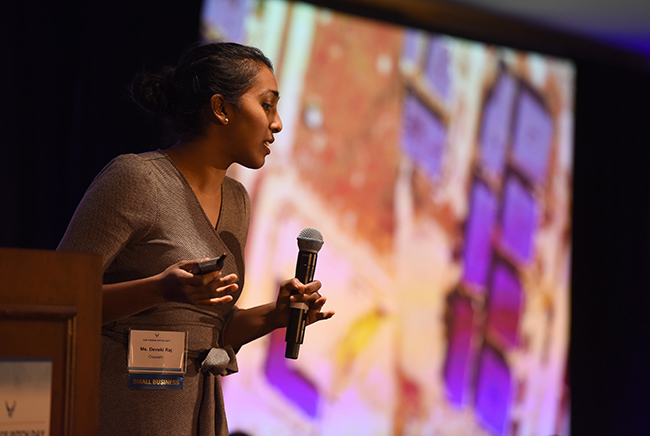
Devaki Raj, CEO and Founder at CrowdAI, pitches her product to a crowd of small businesses, venture capitalists, and airmen during the inaugural Air Force Pitch Day in New York on March 7, 2019. Raj was awarded a same-day contract with the Air Force during the event. Air Force photo by TSgt. Anthony Nelson Jr.
Six months after the Air Force hosted its inaugural Pitch Day in New York, the service’s acquisition boss has ideas about how to improve fast-track contracting.
Will Roper has talked to program offices about soliciting pitches in more traditional, bigger competitions. Under the current Pitch Day construct, companies come in, explain why the Air Force should pay for their product, and potentially leave the event with funding in hand. If that happens for a more major acquisition, it would signal a major shift away from years-long development and procurement processes that shape the Air Force’s key programs.
“Why should we let someone build an airplane or satellite, unless they bring in their design team and production team” Roper told Air Force Magazine at a recent conference outside Washington, D.C. “Show us your passion. Show us your skill set.”
The pitch itself is key, he said. At first, he wasn’t sure companies needed to show up in person for “Shark Tank”-style vetting at all. But after attending all of the Air Force’s Pitch Days to date, Roper has realized that the presentation shows the difference between an eager, smart company that simply needs an introduction to the military purchasing process versus one that is a more typical or familiar contractor.
“Some of the companies that were the highest-rated coming in were the lowest leaving, and vice versa,” he said. “This pitch construct, although it really works well for startups, I think we can use it for scale-ups, and I think we can use it for just normal competitions.”
The initial round of Small Business Innovation Research contracts typically cover six months of costs up to $150,000 to prove out the merit and feasibility of an idea. Phase Two contracts continue those research and development efforts with two-year awards generally worth up to $1 million. The lower the financial bar, the more comfortable the Air Force is investing in a relatively unknown entity.
Now Roper’s question has become: do all companies in the running for Phase One SBIR contracts need to offer their pitches in person
“We could make our Phase Ones smaller [in dollar amount], take greater risk and then do the Phase Twos for bigger awards in person,” he said.
An upcoming space-focused contracting event in California this November could offer the chance to decide whether to tweak the pitch process. Maybe those companies could receive $30,000 to $50,000 in order to mature to Phase Two. Or maybe certain ideas could jump straight to Phase Three, which funds R&D or production with money outside of SBIR.
For now, Roper said he’s leaning toward having companies apply on paper for Phase One seed money and then use live events for Phase Two and Three.
In Phase Two awards, “should it be longer for the pitch, should we do our research better” he asked. “We’re still figuring out the mechanics of how you use live presentations to help us do better acquisitions. I think we’ll end up continuing the live events in some form.”